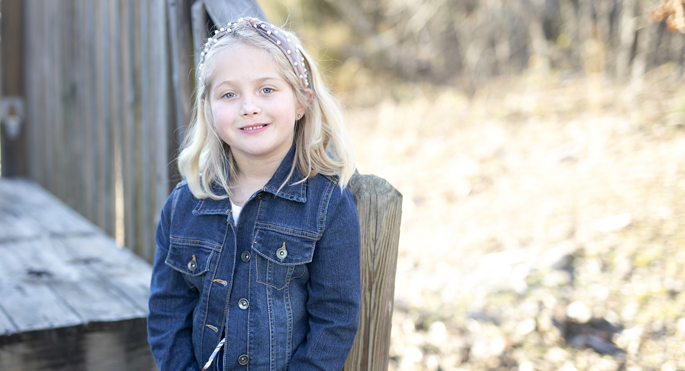
by Nancy Humphrey
Seven-year-old Tinsley Bellar loves to dance — her mother describes it as TikTok dancing with cheerleader moves. She also loves to run. She completed her school’s fun run last year with the whole school cheering her on.
But only three years ago, a walk across her living room using her walker warranted a celebration.
Tinsley, who has cerebral palsy (CP), had a three-hour surgical procedure called selective dorsal rhizotomy in 2018 at Monroe Carell Jr. Children’s Hospital at Vanderbilt to treat muscle spasticity. Two months after the procedure and daily physical therapy, she ditched her walker. “It completely changed everything,” said her mother, Melissa Grove.
According to the Centers for Disease Control and Prevention, CP is the most common motor disability in childhood. Caused by abnormal brain development or damage to the developing brain, it impacts a person’s ability to move, maintain balance and posture and control muscles.
Children’s Hospital is home to the state’s only multidisciplinary clinic for children with CP. It’s also the only place in the state to offer selective dorsal rhizotomy for children with spastic CP, the most common type (about 80%) of the disability.
People with spastic CP have increased muscle tone — stiff muscles — and as a result, their movements can be more difficult. Symptoms vary from person to person, ranging from mild (walking with some difficulty) to more severe (requiring special equipment to walk or not being able to walk at all).
Tinsley fell into the moderately severe category. Her surgery was performed by Robert Naftel, MD, associate professor of Neurological Surgery. During the procedure, performed under general anesthesia, a 1½ – 2-inch incision is made over the lower spinal cord, and nerves are separated and identified by electrical stimulation. Certain sensory nerve fibers in the spine — the ones that lead to too much muscle tone (spasticity) — are cut.
Naftel said about 60% of the nerve fibers are cut — it’s important to leave some portion of each nerve intact so the child doesn’t experience numbness in the legs. Cutting some portion of the nerve decreases the number of abnormal signals and abnormal reflexes.
Following the surgery, patients experience some tingling and weakness in their legs and aren’t able to walk right away. It takes months of intensive daily physical therapy to obtain the desired result.
But Naftel said the biggest predictor of success with the surgery is picking the right patient. “We have a pretty extensive process of identifying children who would do well with this operation, and this involves trying more conservative therapies first.

“My favorite part of doing this particular neurosurgery is that children do really well and have significant improvement to their overall quality of life. With this procedure, when we choose the children properly and set them up with physical therapy afterward, the success rates are extremely high. We can’t make every child walk perfectly normally, but we can make them walk more efficiently, with better endurance and with a less assistive device,” he said.
Prior to her surgery, Tinsley was evaluated at Children’s Hospital’s multidisciplinary spasticity clinic where a group of specialists from Neurosurgery, Developmental Pediatrics, Neurology, Physical Therapy and Physical Medicine and Rehabilitation determine the best treatment for each child.
“We see children affected in many different ways,” Naftel said. “We determine the best way to treat a child, medically or surgically. It’s not a one-size-fits-all decision,” he said. “That’s the strength of having a multidisciplinary clinic. There are many of us who treat CP, but we each treat it differently. A child may need a little bit of something from one of us and a little something from someone else. Seeing patients all together like this allows us to put together a comprehensive, personalized plan that addresses all the needs a child may have.”
In the clinic each child is evaluated for what might help the most. This might include orthotics and equipment; oral medications to improve spasticity or dystonia — injections of botulinum toxin (Botox) or implantation of a baclofen pump, a pump that injects the muscle relaxant baclofen directly into the spinal fluid; or selective dorsal rhizotomy surgery.
Neurodevelopmental disabilities specialist Alice Lawrence, MD, assistant professor of Pediatrics, is medical director of the clinic. She and Naftel are joined by physicians Elizabeth Martin, MD, assistant professor of Physical Medicine and Rehabilitation, and Heather Riordan, MD, assistant professor of Pediatric Neurology, and two physical therapists, Laura Flynn and Jamie Katz.
“With spasticity, it’s like your muscles are firing and contracting all the time,” Martin said. “If kids are having to fight their own muscles for things they’re trying to do, it can cause pain as well as functional difficulties. If you can remove that, or lessen it, everything is so much easier and looser, and kids have better endurance and less pain. It can make a very significant difference for them.”
The Children’s Hospital clinic will continue to see most patients until they turn 21 and graduate to adult care.
“Spasticity affects different children to different degrees,” Lawrence said. “Tight muscles can cause other issues, like orthopaedic problems. It’s not just something that affects you for a short time. It’s a long-term process, and over time different problems can occur. As you grow, you change.”
Tinsley Bellar continues to benefit from her surgery. “She’s got the best little spirit. She’s a dancing fool right now; she loves to dance, sing and perform,” Grove said. “She still falls, but she gets right back up. She’s just a normal 7-year-old.”
Grove said that Tinsley’s father died three months before her surgery. It was a rough time for the family.
“Her surgery was absolutely what we needed. We’re so blessed that she can do all she does. She’s unstoppable. She was in a dance class for kids with special needs, but we’ve moved on from that. I don’t consider her special needs anymore.”












